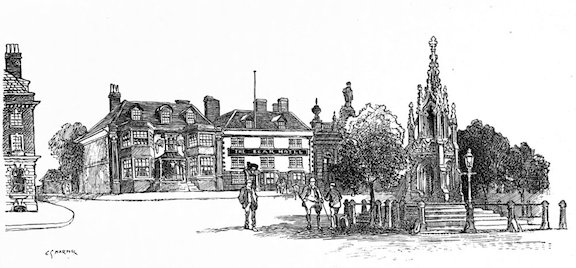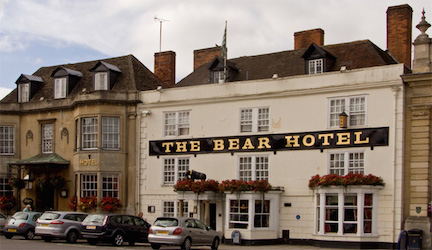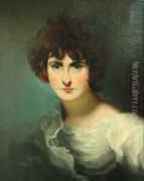The following post is the fourth of a series based on information obtained from a fascinating book Susana recently obtained for research purposes. Coaching Days & Coaching Ways by W. Outram Tristram, first published in 1888, is chock full of commentary about travel and roads and social history told in an entertaining manner, along with a great many fabulous illustrations. A great find for anyone seriously interested in English history!
The Bear Inn
The Bear Inn (or Hotel) in Devizes was a popular stopping-off point for travelers headed for Bath. According to Mr. Tristram, author of Coaching Days & Coaching Ways, the Bear Inn was known for its fine stables. After Bath became a popular retreat for the wealthy elite, the roads also became targets for highwaymen, and many travelers abandoned the normal routes to take the one through Devizes. At its peak, the Bear was taking in up to 30 coaches a day.
Among its more prestigious guests were King George III and Queen Charlotte as well as the Duchess of Kent and Princess Victoria. In 1817, Queen Charlotte wrote that she had had an “elegant repast” at the Bear and that the landlord had put at her disposal “10 pairs of horses as fine as any were put to harness.”
Note: The Bear Hotel continues to be a hotel today. Rooms can be had for as little as 99 pounds. Click here for more information.
Miss Fanny Burney and Hester Thrale Make the Acquaintance of a Young Thomas Lawrence
In April of 1780, Miss Fanny Burney, who later became a famous novelist (Evelina was published anonymously in 1778), was traveling to Bath with her friend and patron, Hester Thrale. While waiting for supper, the pair sat down to cards, but were soon interrupted by the sound of a pianoforte. Following the music, they found the musician to be “a very handsome girl with fine dark hair upon a finely-formed forehead”. Another girl welcomed them and found them chairs, and it was then that the visitors discovered that the girls were the daughters of the hostess of the inn. “Oh, what a surprise!”
“But though these pretty girls struck us much,” she writes, “the wonder of the family was yet to be produced. This was their brother, a most lovely boy of ten years of age, who seems to be not merely the wonder of their family, but of the times, for his astonishing skill at drawing. They protest he has never had any instruction, yet showed us some of his productions, that were really beautiful.”
Apparently, the father of the future Sir Thomas Lawrence was making good use of his son’s talents. Tristram says that:
Instead of offering lame excuses when the roast had gone wrong, or saying that a bad bottle of claret was simply “sick from a journey,” this original in the way of a host, used to simply to introduce his son to the malcontents, and in a moment where there had been disgust there was wonder. At the simple talisman, “Gentlemen, here’s my son; will you have him recite from the poets or take your portraits?” the most confirmed bald-headed grumbler ceased his monotonous drone, and the storm in the coffee-room fell before the smile of the young genius.
The Rise To Fame Of Sir Thomas Lawrence
By the time the family moved to Bath soon after this encounter, young Thomas was supporting his family drawing portraits in pastel. Due to his talent, charm and good looks, Thomas became very popular about Bath society and was allowed to view private art collections. In 1787, at the age of not quite eighteen, he established a studio in London, settling his parents nearby. In 1788 he exhibited five portraits in pastel and one in oil. In 1789 he exhibited 13 portraits, mostly in oil, to critical acclaim. At age 20, he received his first royal commission, portraits of Queen Charlotte and Princess Amelia. After the death of Sir Joshua Reynolds in 1792, George III appointed him “painter-in-ordinary-to-his-majesty.” In 1794, he became a full member of the Royal Academy. He went on to paint many portraits of the elite, as well as important figures in the war with Napoleon, and even the Pope. In 1815 he was knighted, and in 1820 he became President of the Royal Academy.
Sir Thomas and the Siddons Sisters
Thomas fell in love with Sally Siddons, one of the daughters of the famous actress, Sarah Siddons. But then he fell in love with her sister Maria. But then he decided to go back with Sally. (Imagine the turmoil in that household!) But neither of the girls was healthy. Before Maria died in 1798, she got her sister to promise not to marry him. Sally did not, refusing to see him for the five years before she herself passed away.
Lawrence never married. His companions in later life were Elizabeth Croft (half-sister of Sir Richard Croft, the accoucheur who apparently botched the delivery of Princess Charlotte’s son and who committed suicide soon after) and Isabella Wolff, separated from her husband and whose son Herman may have been Lawrence’s.
Plagued With Financial Problems
One might expect that, with all the commissions pouring in and his prolific work ethic, Lawrence should be a wealthy man. On the contrary, he was constantly in debt, to the point where he seemed to be always on the brink of bankruptcy and had to be rescued by his friends, dying insolvent. Nobody is quite sure why this was, except for an assumption that he was unable to keep good accounts, and perhaps he was too generous with family and friends. He himself wrote:
“I have never been extravagant nor profligate in the use of money. Neither gaming, horses, curricles, expensive entertainments, nor secret sources of ruin from vulgar licentiousness have swept it from me.”
Legacy
The director of the National Portrait Gallery described Lawrence as “a huge figure. But a huge figure who we believe deserves a great deal more attention. He is one of the great painters of the last 250 years and one of the great stars of portraiture on a European stage.”
Index to all the posts in this series
1: The Bath Road: The (True) Legend of the Berkshire Lady
2: The Bath Road: Littlecote and Wild William Darrell
3: The Bath Road: Lacock Abbey
4: The Bath Road: The Bear Inn at Devizes and the “Pictorial Chronicler of the Regency”
5: The Exeter Road: Flying Machines, Muddy Roads and Well-Mannered Highwaymen
6: The Exeter Road: A Foolish Coachman, a Dreadful Snowstorm and a Romance
7: The Exeter Road in 1823: A Myriad of Changes in Fifty Years
8: The Exeter Road: Basingstoke, Andover and Salisbury and the Events They Witnessed
9: The Exeter Road: The Weyhill Fair, Amesbury Abbey and the Extraordinary Duchess of Queensberry
10: The Exeter Road: Stonehenge, Dorchester and the Sad Story of the Monmouth Uprising
11: The Portsmouth Road: Royal Road or Road of Assassination?
12: The Brighton Road: “The Most Nearly Perfect, and Certainly the Most Fashionable of All”
13: The Dover Road: “Rich crowds of historical figures”
14: The Dover Road: Blackheath and Dartford
15: The Dover Road: Rochester and Charles Dickens
16: The Dover Road: William Clements, Gentleman Coachman
17: The York Road: Hadley Green, Barnet
18: The York Road: Enfield Chase and the Gunpowder Treason Plot
19: The York Road: The Stamford Regent Faces the Peril of a Flood
20: The York Road: The Inns at Stilton
21: The Holyhead Road: The Gunpowder Treason Plot
22: The Holyhead Road: Three Notable Coaching Accidents
23: The Holyhead Road: Old Lal the Legless Man and His Extraordinary Flying Machine
26: Flying Machines and Waggons and What It Was Like To Travel in Them










